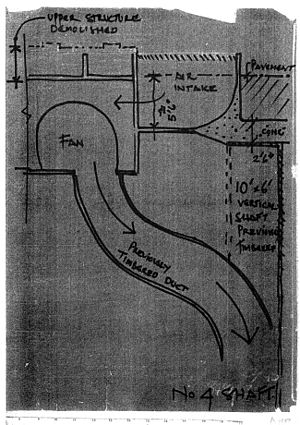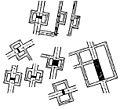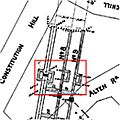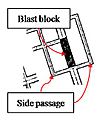Albert Park tunnels facts for kids
The Albert Park tunnels are a secret network of underground passages hidden beneath Albert Park in central Auckland, New Zealand. These tunnels were built as air raid shelters during World War II, a big global conflict. After the war ended, the tunnels were sealed up. This was done to keep people safe and prevent any damage or misuse.
Contents
Why the Tunnels Were Built
New Zealand joined World War II in 1939. When enemy ships were seen near New Zealand, the country needed to prepare for attacks. Things became very serious when Japan joined the war in 1941.
Auckland already had some coastal defences. But the Auckland City Council felt the city needed more protection. They wanted places where people could hide during air raids. So, in December 1941, work began. By January 1942, over 16,000 feet of trenches were dug. Other shelters were made in basements, the Domain, and an old railway tunnel.
Choosing Albert Park for Shelters
Auckland's city centre had about 70,000 people during the day. But by April 1942, there was only enough shelter for 20,000. Also, people learned from the Blitz in Britain that deep shelters were much safer. Albert Park was chosen because it was in the city centre and had good ground. It was also the site of an old army camp. In 1942, a large system of tunnels was built under the park. These tunnels could protect 20,400 people.
City engineer James Tyler designed the tunnels. They were expected to cost about £120,000. The government paid most of this, and Auckland City paid the rest. Work started in February 1942. Up to 300 men worked in shifts, day and night, six days a week. The digging finished in August. More work like carpentry and plumbing was added later. The tunnels officially opened in October 1942.
How the Tunnels Were Built
There are more than 3.5 kilometres (2.2 mi) of tunnels under Albert Park. They stretch from Constitution Hill to Wellesley Street. This network included shelters, toilets, and first aid stations. Air shafts helped with ventilation. There were nine entrances in total.
The tunnels were dug through sandstone and volcanic rock. Most of the digging was done by hand. About 114 council workers, many of whom were middle-aged men not fit for war, did this tough job. The tunnels were lined with over 975 km of New Zealand native wood. This included Kauri, Heart Rimu, Larch, and New Zealand Stringy Bark. In total, 315 people worked on this huge project.
Tunnel Design and Features
The main tunnels were 9 ft high (2.7 m) and 15 ft wide (4.6 m). They were about 3,700 ft long (1,100 m). The smaller rooms, called accommodation galleries, were 7 ft (2.1 m) square. These rooms had wooden seating. The floors were covered with scoria, a type of volcanic rock.
Unlike many other air raid shelters, these tunnels did not have heavy blast doors. Instead, they had "baffles." A baffle was a block built in a tunnel. It was made of wood, lead, and stone. Its job was to soak up the shock wave if a bomb exploded nearby. Small tunnels around the baffles allowed people to pass. They also helped to reduce the bomb's shock.
A diesel engine from an old meatworks powered the tunnels. It ran the ventilation fans and emergency lights. It also powered a loudspeaker system, so people could hear announcements.
After the War
The expected air raids on Auckland never happened. By late 1943, the wooden supports in the unused tunnels began to weaken. By February 1945, there wasn't enough money to fix or change the tunnels for other uses. So, plans were made to fill them in.
The tunnels were filled with 8.8 million unfired clay blocks. These blocks were made by Crum Brick and Tile in New Lynn. It took 15 men 12 months to fill the tunnels. The entrances were sealed and buried by April 18, 1946.
Ideas for Reopening the Tunnels
Since then, many ideas have come up to use the tunnels again. In the 1960s, newspapers wrote about different proposals. Interest grew again in the 1990s. A businessman wanted to open them as a tourist attraction. A group of architecture students thought the tunnels could help with Auckland's traffic problems.
In 1996, the city council signed a deal with a tourism promoter named William Reid. He was allowed to unseal the tunnels and inspect them. The goal was to see if they could become a tourist spot. Laws related to this were passed in 2001.
In 2005, parts of the park's ground sank. This happened because the soil inside the old ventilation shafts collapsed. Today, you can still see blocked entrances. One is hidden by a decorative wall at the top of Victoria Street. Another is a steel door at the foot of Constitution Hill. Three more blocked entrances are behind the Park's Gateway sculpture.
As of June 2012, two Auckland residents, Bill Reid and Mark Howarth, were planning to dig out the first 25 meters of one tunnel. They wanted to create a museum about its history. However, the Auckland Council said no official work had been done to reopen the tunnels.
In January 2017, Bill Reid met with Auckland Tourism, Events and Economic Development (ATEED). He continued to push for the tunnels to be reopened. He suggested they could be a tourist attraction and a direct path for walkers and cyclists between Victoria Street and Parnell.







